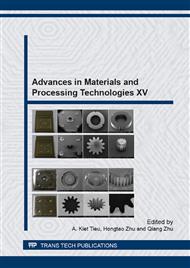p.661
p.670
p.678
p.687
p.697
p.705
p.712
p.725
p.732
Investigation of Characteristics of Ni-P-PTFE Coating on Optical Molds
Abstract:
In recent years, plastic lenses have been widely adopted for optical components in consumer products because of the significant improvement in microelectronics technology. Currently, plastic lenses are mass produced for applications in 3G/4G smart mobile phones, digital still/motion cameras, and micro-projectors. During mass production, one of the key factors in costs reduction is to enhance lifetime of the molding tools. Electroless nickel phosphorus plating (Ni-P) is the most popular mold and die surface treatment process because of its excellent machinability in single-point diamond turning process. However, Ni-P plated molds cannot sustain satisfactory tool life under the adhesion forces between the mold surface and the molten plastic. In this study, a novel material made of a nickel-phosphorus-polytetrafluoroethylene (Ni-P-PTFE) compound was plated electrolessly on experimental dies to study relevant properties. Since Ni-P-PTFE exhibits strong anti-adhesion properties, it is noted to improve the lifetime of the dies. After machining of the dies, the surface roughness was measured by confocal microscopy together with the particle size being measured by scanning electron microscopy (SEM). In conclusion, the adhesion phenomenon is interpreted via hydrophobic contact angles showing that hydrophobic contact angle of Ni-P-PTFE surfaces is smaller when compared to Ni-P surfaces which infers the anti-adhesion properties of Ni-P-PTFE materials.
Info:
Periodical:
Pages:
697-704
Citation:
Online since:
November 2013
Authors:
Keywords:
Price:
Сopyright:
© 2014 Trans Tech Publications Ltd. All Rights Reserved
Share:
Citation:


